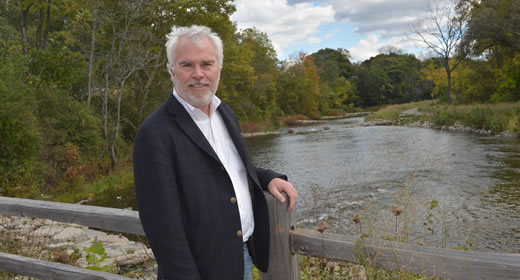
Matt Naud, environmental coordinator for the city of Ann Arbor, talks environmental innovation
Fourteen years ago, the City of Ann Arbor launched a new commission on the environment. The group would report annually on the state of the environment, hold public hearings on environmental issues, and advise the city on relevant policy. But it needed an administrator— someone with expertise in policy, analysis, science, and governance—to be effective. Matt Naud (MPP ’90) was hired to fill that role, and has been filling it ever since.
To be sure, the environmental coordinator position has grown to fit Naud, now a nationally recognized leader in sustainability. In 2009, Naud took on leadership roles with the Urban Sustainability Directors Network, a peer-to-peer learning network of the lead sustainability staff in cities across North America. In 2010, Naud helped to develop the Michigan Green Communities Network, 90 Michigan communities sharing best practices in sustainability. This summer, he was one of ten city sustainability directors tapped to visit Copenhagen and Malmo, internationally renowned leaders in carbon reduction. This fall, he joins the EPA’s Board of Scientific Counselors, serving on the Sustainable and Healthy Communities Committee.
While Naud is excited about opportunities to learn from other cities, he feels lucky to be in Ann Arbor. “For a city our size,” he says, “we have good, paid, professional staff dedicated to environmental sustainability.” He mentions the city’s single-stream recycling program, its comprehensive composting program, its stormwater utility. All of those pathsetting programs were driven by research and analysis, notes Naud with some pride. “We’re looked at as those lefty-liberal Birk-wearers, but we analyze and evaluate everything we do.”
In 2006, Naud helped to develop a residential phosphorous ordinance, one estimated to produce a 20 percent reduction in phosphorous, then looked around for ways to measure the impact. “U-M had great baseline data on phosphorous content up and down the Huron,” says Naud, so the city partnered with the University to monitor the outcome. “While it’s hard to make a direct causal link in such a noisy system,” says Naud, “U-M data showed a 17-30 percent reduction.”
In 2010, the state followed Ann Arbor’s lead and passed a residential phosphorous ordinance of its own.
Naud’s current passion is greening the city’s rental housing, a huge endeavor in a city where half the housing stock is rental. “U-M draws 7,000 new renters a year,” says Naud. “They’re very bright young people, but many have never signed a lease.” Young renters might not feel confident negotiating with landlords who, Naud notes, have few market-based incentives to winterize or upgrade when they’re not paying the utility bills. So Naud tapped his colleague Jamie Kidwell to work with a team of U-M students, Dow Sustainability Fellows, to create a market-based solution: a low-interest revolving loan fund for landlords seeking energy efficiency upgrades.
“Cities are really where innovative things are happening in sustainability,” says Naud, who recommends the work to the Ford School students he meets and mentors (five Dow Sustainability Fellows, and three alumni of the program, study policy). “Most of my colleagues could be doing other stuff—important stuff—but they’re working with cities because they love to innovate.”
Below is a formatted version of this article from State & Hill, the magazine of the Ford School. View the entire Fall 2014 State & Hill here.